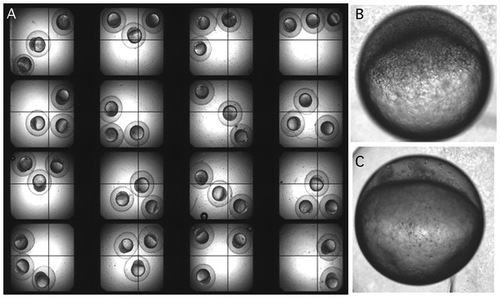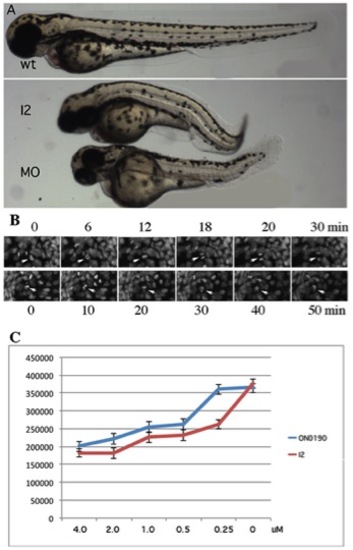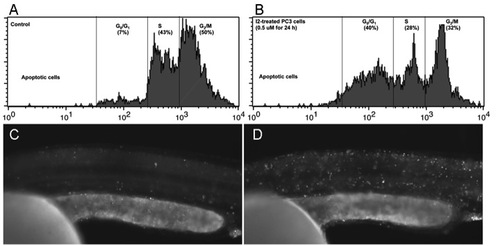- Title
-
A Novel Anti-Tumor Inhibitor Identified by Virtual Screen with PLK1 Structure and Zebrafish Assay
- Authors
- Lu, J., Xin, S., Meng, H., Veldman, M., Schoenfeld, D., Che, C., Yan, R., Zhong, H., Li, S., and Lin, S.
- Source
- Full text @ PLoS One
|
Screening for mitotic inhibitor using zebrafish embryo. p>A. Embryos were incubated with compounds in multi well plates and visualized under a dissection microscope. A compound was considered as positive if division of all three embryos in the well was inhibited. B. A normal embryo after 4 hours of development. C. An embryo with cell division inhibited at 1 cell stage when an active inhibitor was present even after 4 hours of development. |
|
Analysis of I2 specificity against PLK1. A. Comparison of zebrafish embryonic phenotype induced by I2 inhibition and Plk1 morpholino. Wild type embryo (upper) developed normally whereas I2 treated embryos (middle) and Plk1 morpholino injected embryo (lower) were shorter and appeared similarly deformed. B. Inhibition of chromosomal segregation in live zebrafish embryos. H2A GFP labeled chromosomes in wild type controls segregated in approximately 15 minutes (arrows, the upper panel) while the chromosomes (arrows, lower panel) of I2 treated embryo attempted to segregate but failed to do so after 50 minutes. C. Inhibition of PLK1 enzyme activity by I2 and ON01910. The values of three independent assays were averaged. |
|
Cell cycle and apopotosis analysis in I2 treated cells and zebrafish embryo. A. PC-3 cells treated with DMSO and B. PC-3 cells treated with 0.5μM I2. C. Zebrafish embryo treated with DMSO and D. treated with I2. Bright fluorescence represents apopototic cells. To conduct cell cycle analysis by propidium iodide (PI) staining in I2-treated PC-3 cells, PC-3 cells were treated with I2 at dose of 0.5 μM for 24 hours, using PBS as control. Treated cells were trypsinized, suspended in complete DMEM medium, centrifuged at 1,500 rpm for 5 min, and the pellet was suspended in PBS. After fixing the cells in 4% paraformaldehyde for 16 hours at 4 °C, the cells were transferred into PBS containing PI (50 !g/ml), RNase A (0.1 mg/ml) and Triton X-100 (0.05%, w/w). After incubation for 60 min at 37°C, the cells were collected down by centrifuge and washed by PBS for another time. Cells were analyzed by SCAN flow cytometer (Becton Dickinson, Mountain View, CA) using mean FL-2 to assess PI fluorescence. Zebrafish embryos were treated with I2 (5μM) from late gastrulation stage and stained with acridine orange to detect apoptosis in living embryos at 24 hpf. Acridine orange was dissolved in Holtreter’s buffer (5 mg/ml) and embryos were stained at 5 μg/ml for 30 min in Holtreter’s buffer followed by washing embryos three times with the same buffer for 5 min each and imaging under a fluorescence microscope |



